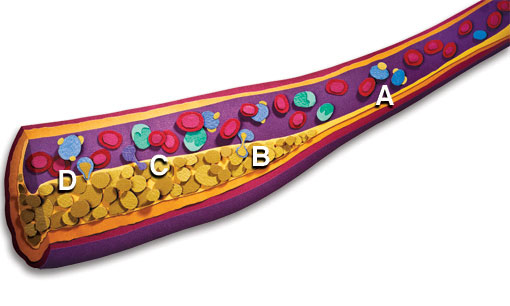
INFLAMMATION IS ONE OF THE DRIVING FACTORS in atherosclerosis, the narrowing of the arteries that leads to many heart attacks and strokes. Research at UAB and elsewhere
is focusing on a promising target: good cholesterol.
A. LDL particles (“bad” cholesterol, shown in blue) are supposed to ferry lipids (yellow) through the bloodstream to cells that need them—to repair their walls, for instance.
B. When LDL comes across sections of arterial walls that have been damaged—by high blood pressure or smoking, for example—it tends to squeeze into the cracks and deposit its cholesterol payload. These cholesterol deposits become oxidized, in the same process that occurs when an apple turns brown or metal rusts. That’s where inflammation steps in.
C. The immune system sends in macrophages to deal with the festering mess. They get the job done, swallowing the cholesterol particles, but this isn’t a permanent solution. As more and more cholesterol becomes packed in to the trouble spot, the body covers the resulting mound, known as a plaque, with a thick coating. The macrophages die, which attracts more inflammatory particles. This can eventually cause the coating to weaken and rupture, leading to blood clots or blockages of the artery.
D. “Good” cholesterol could be the answer. HDL reduces cholesterol in the bloodstream by carrying it to the liver for excretion. But it can also—by a process known as reverse cholesterol transport—actually travel into atherosclerotic lesions and remove cholesterol particles for destruction in the liver. UAB researchers have designed two drugs that improve on HDL’s anti-cholesterol, anti-inflammatory qualities.